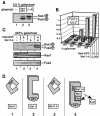Mitogen-activated protein kinases with distinct requirements for Ste5 scaffolding influence signaling specificity in Saccharomyces cerevisiae
- PMID: 15713635
- PMCID: PMC549360
- DOI: 10.1128/MCB.25.5.1793-1803.2005
Mitogen-activated protein kinases with distinct requirements for Ste5 scaffolding influence signaling specificity in Saccharomyces cerevisiae
Abstract
Scaffold proteins are believed to enhance specificity in cell signaling when different pathways share common components. The prototype scaffold Ste5 binds to multiple components of the Saccharomyces cerevisiae mating pheromone response pathway, thereby conducting the mating signal to the Fus3 mitogen-activated protein kinase (MAPK). Some of the kinases that Ste5 binds to, however, are also shared with other pathways. Thus, it has been presumed that Ste5 prevents its bound kinases from transgressing into other pathways and protects them from intrusions from those pathways. Here we found that Fus3MAPK required Ste5 scaffolding to receive legitimate signals from the mating pathway as well as misdirected signals leaking from other pathways. Furthermore, increasing the cellular concentration of active Ste5 enhanced the channeling of inappropriate stimuli to Fus3. This aberrant signal crossover resulted in the erroneous induction of cell cycle arrest and mating. In contrast to Fus3, the Kss1 MAPK did not require Ste5 scaffolding to receive either authentic or leaking signals. Furthermore, the Ste11 kinase, once activated via Ste5, was able to signal to Kss1 independently of Ste5 scaffolding. These results argue that Ste5 does not act as a barrier that actively prevents signal crossover to Fus3 and that Ste5 may not effectively sequester its activated kinases away from other pathways. Rather, we suggest that specificity in this network is promoted by the selective activation of Ste5 and the distinct requirements of the MAPKs for Ste5 scaffolding.
Figures







Similar articles
-
Saccharomyces cerevisiae Ste5 is important for induction and substrate specificity of Fus3 MAP kinase in the pheromone signaling pathway.Mol Cells. 2000 Jun 30;10(3):301-8. Mol Cells. 2000. PMID: 10901168
-
Persistent activation by constitutive Ste7 promotes Kss1-mediated invasive growth but fails to support Fus3-dependent mating in yeast.Mol Cell Biol. 2004 Oct;24(20):9221-38. doi: 10.1128/MCB.24.20.9221-9238.2004. Mol Cell Biol. 2004. PMID: 15456892 Free PMC article.
-
The Ste5 scaffold directs mating signaling by catalytically unlocking the Fus3 MAP kinase for activation.Cell. 2009 Mar 20;136(6):1085-97. doi: 10.1016/j.cell.2009.01.049. Cell. 2009. PMID: 19303851 Free PMC article.
-
Pheromone response, mating and cell biology.Curr Opin Microbiol. 2000 Dec;3(6):573-81. doi: 10.1016/s1369-5274(00)00143-0. Curr Opin Microbiol. 2000. PMID: 11121776 Review.
-
Dynamics and organization of MAP kinase signal pathways.Mol Reprod Dev. 1995 Dec;42(4):477-85. doi: 10.1002/mrd.1080420416. Mol Reprod Dev. 1995. PMID: 8607979 Review.
Cited by
-
Mechanisms regulating the protein kinases of Saccharomyces cerevisiae.Eukaryot Cell. 2007 Apr;6(4):571-83. doi: 10.1128/EC.00026-07. Epub 2007 Mar 2. Eukaryot Cell. 2007. PMID: 17337635 Free PMC article. Review. No abstract available.
-
Dynamic studies of scaffold-dependent mating pathway in yeast.Biophys J. 2006 Dec 1;91(11):3986-4001. doi: 10.1529/biophysj.106.081661. Epub 2006 Sep 15. Biophys J. 2006. PMID: 16980360 Free PMC article.
-
Osmostress enhances activating phosphorylation of Hog1 MAP kinase by mono-phosphorylated Pbs2 MAP2K.EMBO J. 2020 Mar 2;39(5):e103444. doi: 10.15252/embj.2019103444. Epub 2020 Feb 3. EMBO J. 2020. PMID: 32011004 Free PMC article.
-
Analysis of the thresholds for transcriptional activation by the yeast MAP kinases Fus3 and Kss1.Mol Biol Cell. 2018 Mar 1;29(5):669-682. doi: 10.1091/mbc.E17-10-0578. Epub 2018 Jan 10. Mol Biol Cell. 2018. PMID: 29321252 Free PMC article.
-
Analysis of mitogen-activated protein kinase activation and interactions with regulators and substrates.Methods. 2006 Nov;40(3):213-23. doi: 10.1016/j.ymeth.2006.06.008. Methods. 2006. PMID: 16884917 Free PMC article. Review.
References
-
- Bardwell, L., J. G. Cook, E. C. Chang, B. R. Cairns, and J. Thorner. 1996. Signaling in the yeast pheromone response pathway: specific and high-affinity interaction of the mitogen-activated protein (MAP) kinases Kss1 and Fus3 with the upstream MAP kinase kinase Ste7. Mol. Cell. Biol. 16:3637-3650. - PMC - PubMed
Publication types
MeSH terms
Substances
Grants and funding
LinkOut - more resources
Full Text Sources
Molecular Biology Databases
